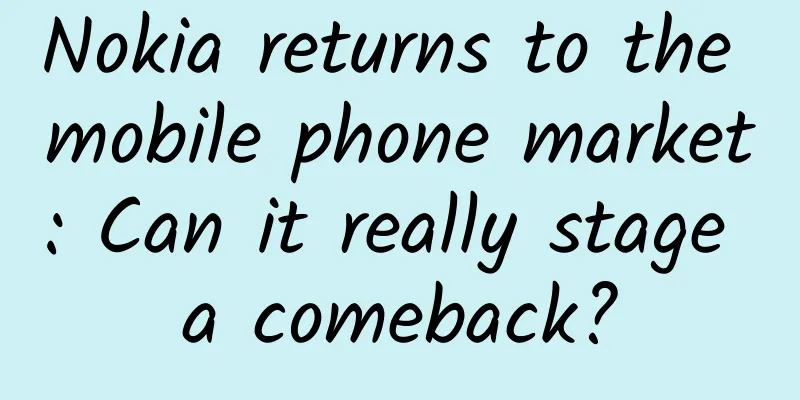Nokia returns to the mobile phone market: Can it really stage a comeback?

|
Recently, after Nokia spent a lot of money to acquire Alcatel-Lucent, there were rumors that Nokia is likely to return to the mobile phone market in the fall of 2016 as the terms of Microsoft's acquisition of Nokia's mobile phone business will be lifted next year. Many reasons were listed to prove that Nokia is likely to make a comeback in the mobile phone market. Is this really the case? First, the industry believes that Nokia's most important asset for returning to the smartphone industry is that it is still the most valuable brand in the field of mobile phones and mobile devices. This view is not entirely unreasonable, but the only thing overlooked is that Nokia's golden age of brand influence in the mobile phone industry was the era of feature phones. Since entering the era of smartphones represented by Apple's iPhone, Nokia's brand influence has shrunk significantly, and even became a synonym for hindering the innovation, development and transformation of the smartphone industry. Looking at reports on the smartphone-related industry, Nokia is almost always mentioned in a negative light. Even before Microsoft changed its name after acquiring Nokia, a related survey showed that as many as 73% of respondents hoped to use the Lumia brand instead of the Nokia brand on future Lumia devices. As a well-known fact, Lumia is the product of the strategic cooperation between Nokia and Microsoft using the Windows Phone system. In other words, in terms of brand attributes, the industry more often associates it with Microsoft. Otherwise, Microsoft would not have retained and adopted the Lumia product brand when it merged Nokia's mobile phone business and changed its name. In addition, according to rumors, Nokia will return to the smartphone market as early as the fall of 2016. Judging from the current development characteristics of the smartphone industry, except for Apple, the stickiness of brands in the market and users is not high. Samsung, whose brand awareness was second only to Apple before, has declined sharply in the smartphone industry. In addition, the driving force of the smartphone industry is shifting to cost-effectiveness, which has further reduced brand loyalty. This has reduced the value of Nokia's return to the mobile phone industry, which we mentioned earlier, using its own brand as the main capital. In addition to the brand, the industry believes that Nokia's capital for returning to the smartphone market is the so-called patents. It is undeniable that Nokia does have strong strength in patents. But it is a well-known fact that patents are generally used for strategic defense. That is, against manufacturers that adopt or infringe their own patents, use lawsuits to slow down the opponent's progress or increase the opponent's costs in disguise by charging special fees. Although this will cause trouble to the opponent and even hinder the opponent's progress in some cases, the opponent's decline does not mean its own rise. Otherwise, Nokia would have benefited from this strategy long before being acquired by Microsoft, and would not have ended up with the tragic ending of being acquired. The so-called patents here are at best an external factor for Nokia to change itself. What is important is to improve the innovation and competitiveness of its own mobile phones, which is the internal factor of change. Speaking of innovation in mobile phones (including tablets), Nokia's Nokia X mobile phone and Nokia N1 tablet are nothing more than customized Android products, which means that it has to join the fierce competition in the Android camp. Although the market response to these two products was good in the early stage and the publicity was very high-profile, they were eventually abandoned. It is said that the sales volume of Nokia N1 tablet reached 20,000 units 4 minutes and 2 seconds after it went on sale. Two days later, Nokia announced that the number of orders for N1 had exceeded 560,000 units, and there was no further news. As for Nokia X, it is said that the number of pre-orders exceeded 10 million units, but there is no statistics on how many were actually sold in the end. It seems that the final market performance is far from what we see on the surface. The key is that it is not difficult to see Nokia's product strategy for returning to the mobile phone market from these two products. Apart from competing on price, there seems to be nothing new. When it comes to competing on price, everyone knows that no manufacturer can compete with Chinese companies. Samsung's decline is an obvious example. Finally, Nokia is not short of money now. This is indeed very important. After all, the current smartphone market is fiercely competitive. As a former loser, it costs more to re-enter this industry and find its foothold again than before. Investment (including product research and development, marketing, channels, etc.) naturally requires financial support. So the question is, is Nokia really rich as the industry says? According to statistics, after Nokia announced the acquisition of Alcatel-Lucent recently, it may have 7 billion euros in cash reserves. If its map business Here is sold in the future, according to Inderes Securities' valuation of its business of 4.68 billion to 7.34 billion US dollars, Nokia's total cash reserves will be about 15 billion US dollars. It is difficult for us to estimate whether this 15 billion US dollars is enough for a company that returns to an industry and hopes to make a comeback. However, Intel and Microsoft have invested tens of billions of dollars in the tablet and smartphone markets before, and Microsoft has even invested 7.2 billion US dollars at once (acquiring Nokia's mobile phone business) to maintain its presence in the smartphone market, but the market effect is very small. Does Nokia really have enough money with this 15 billion US dollars? In fact, Nokia CEO Rajeev Suri refuted the rumors that Nokia would re-manufacture mobile phones last year, saying that Nokia would not return to the mobile phone market. When talking about the rumors that Nokia was considering re-producing mobile phones, Suri pointed out that "we will no longer produce mobile phones ourselves", but through the licensing agreement, Nokia's "brand will return to the consumer world, and the Nokia brand is still strong." But as we analyzed at the beginning of our article, Nokia's brand is no longer what it used to be. So even if it is authorized, which and how many manufacturers are willing to be Nokia's OEM manufacturers? This has to remind us of Intel and Microsoft, who are struggling in the smartphone and tablet market. In order to make Intel Inside and Windows Phone appear in OEM manufacturers' products, Intel did not hesitate to subsidize OEM manufacturers, and Microsoft even changed its inherent Windows business model (from licensing fees to free), but unfortunately, so far, there are still very few manufacturers who follow suit. Based on the above analysis, we believe that if Nokia really returns to the mobile phone market next year as rumored, it will not only fail to make a comeback as a king, but may also repeat its previous failure in the smartphone market. As a winner of Toutiao's Qingyun Plan and Baijiahao's Bai+ Plan, the 2019 Baidu Digital Author of the Year, the Baijiahao's Most Popular Author in the Technology Field, the 2019 Sogou Technology and Culture Author, and the 2021 Baijiahao Quarterly Influential Creator, he has won many awards, including the 2013 Sohu Best Industry Media Person, the 2015 China New Media Entrepreneurship Competition Beijing Third Place, the 2015 Guangmang Experience Award, the 2015 China New Media Entrepreneurship Competition Finals Third Place, and the 2018 Baidu Dynamic Annual Powerful Celebrity. |
<<: Who will be the leader in the video website industry in the next five years?
>>: What is missing for domestic mobile phones to challenge Samsung?
Recommend
Live streaming + private domain traffic, an efficient marketing method in 2020!
Since 2020, two concepts have been very popular a...
How much does it cost to join a building materials mini program in Wuwei?
How much does it cost to join the Wuwei building ...
Don’t be afraid, talking about money with users is not that scary!
Does anyone have this feeling? Many operators are...
World Pancreatic Cancer Day丨I thought it was stomach pain, but it was actually the "king of cancer"! This cancer is so "violent" that the five-year survival rate is less than 10%
Pancreatic cancer, a malignant disease originatin...
App Store launch rules, app launch, app release, app promotion
Rules for the first release of App Store 1. Initi...
There is a cure for those who always have trouble sleeping! Experts give 7 simple and effective dietary nutrition suggestions!
Sleep disorders are common physical functional di...
Baidu enters the TV market: the foresight of a "latecomer"
Making cars can no longer satisfy Baidu. On Augus...
The sound of a cat purring remains a mystery
© Hella Health Leviathan Press: Patting the butto...
Architecture design: a design concept for remote call services (an application practice of zookeeper)
Before learning Zookeeper in depth, I would like ...
The cleanest place on earth is dirty
From November 30 to December 2, 2019, in order to...
Chinese scientists decipher ancient mystery of biosynthesis
Chitin biosynthesis is an ancient and conserved s...
China Merchants Bank APP User Incentive Program Report
With the diversification of finance today, bankin...
The incubation period can be as long as 20 years! Here are the methods to prevent Alzheimer's disease
Expert of this article: Zhao Jing, attending phys...
5 Best Paid App Promotion Methods in 2015
Nowadays, if an APP wants to survive, it must hav...
Harbor Seal Protection Promotion Day丨West Pacific Harbor Seal, the "top predator" in the Yellow Sea and Bohai Sea
The West Pacific spotted seals are mainly distrib...









